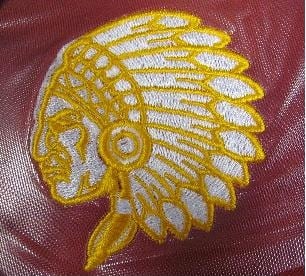How to repair an embroidery design that sews out of registration is a constant problem that most embroiderers face and are very often stuck .When your Embroidery design on your finished garments do not look as good as your design sew out, this creates a huge problem. Sometimes it can be solved and sometimes the garments are totally wasted!
The problem with this design was created by an embroidery machine operator and it could have been totally avoided. I have always been adamant about making sure that the design sew out was done on the same type of fabric that you are going to be using for your finished garments. This is very important and will pay off in big dividends in both quality of embroidery and time.
As I am working with an embroidery company trying to help reorganized their production and get it up to speed, an issue came up that is very common with many embroiderers, especially new or inexperienced embroiderers.
One of the embroidery machine operators sewed out a design they had received back from the digitizer. She created her sew out to make sure that the design was OK and ready for production. She then embroidered her 6 knit shirts for the customer on an 8 head machine. When she finished them, they were way off registration and it caused the material in the shirt to look stretched around the embroidery.
What caused this Design Registration to be so far off?
She called me over to look at the problem and wanted to know why it happened. She also wanted to know what she could have done to avoid this and how to get this issue solved. The shirts were quite expensive and they are totally unacceptable the way that they are.
I was shocked as to how bad it looked when I first saw it. I quizzed her about her process, what fabric she used for the sew out, what thread she used, how did she have it hooped and how her tensions were set. She created her sew out on 2 layers of firm cutaway backing.
Her sew out was NOT done on the right type of fabric; that was her main problem! You always use the same type of fabric, or very similar, that your finished garments are going to be. She also used 2 layers of a heavy cutaway backing, and the hoops were not tight enough. The backing was much too heavy for the shirt or design. She would have been better off with a lighter weight backing such as a 2 oz cutaway or the No Show cutaway backing. The No Show backing is a mesh backing that holds up very well with a lot of stitches and yet it keeps the garment soft and pliable. She was correct in using a topping on the top of the garment.
Now the question is, how do you solve this problem?
It is very important for every embroiderer to know how to repair an embroidery design. Here is a simple way to make your repair.
- First of all, do not remove the garment from the hoop or the topping from the top of the embroidery. Lay the garment face down over a firm surface and use a tool called “Peggy‚’s Stitch Eraser” and remove the stitching from the backside of the garment. I use a large candle jar, one with a smooth bottom, turned upside down. You must be very careful that you do not cut any holes into the fabric.
- After you have removed all the stitching and thoroughly cleaned up all of the threads, it is time to embroider the design again.
- This time you must increase the size of your design by 2 or 3 percent. This will be large enough to cover everything that you removed.
- You must make sure that you do not loosen the hoop as you are removing the stitches. This is very important. If you do, you will need to tighten the hooped area before you begin sewing out the design, and it makes it more difficult to line it up.
Repair your Embroidery on a Single Head Embroidery Machine!
- You already have it hooped so you are not going to re-hoop your garment to add new backing.
- Load the hooped garment back into the machine and lay new backing down under the hoop. For this you will need to use 1 head only because you are not going to be able to line up all 6 shirts to sew out perfectly on the multi-head machine when you are repairing a design like this.
- Print out a new design sheet of the larger sized design, cut it out following around the edge of the design and lay it inside the hoop covering the entire area that had the embroidery removed. Make sure that you have the center starting point of the design marked on the design print.
- Line up the needle with the center starting point.
- Remove the cut out print, lay down a piece of topping and tape it into place. Now you are ready to re-embroider the design.
This repair method did solve the problem with this order but this embroidery machine operator will make sure that she uses the correct fabric for her sew out the next time and will also use the correct backing. This is a problem that could have been totally avoided if she had been instructed properly, however, every embroiderer need to know how to repair an embroidery design.

